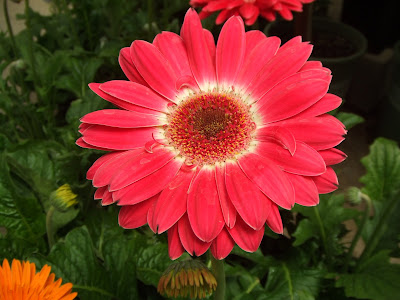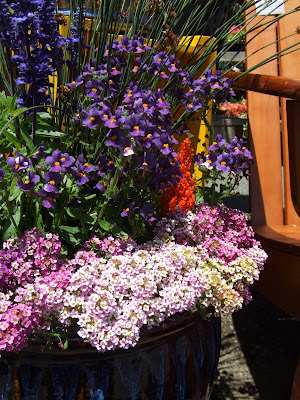
Friday, May 29, 2009
A new thrips species...

The new pest is Klambothrips myopori, a recently discovered thrip species from Australia that was first detected in San Diego County in 2006. It has successfully traveled north along the coast and was first detected in the San Francisco Bay Area in June 2008. Both the Myoporum laetum ‘ Carsonii’ and the Prostrate Myoporum are affected. Thrips distort foliage on terminal shoots causing the leaves to swell, curl, develop galls and ultimately blacken. Eventually, the plants may defoliate and die if the insects are not controlled.
The minute pirate bug and assassin beetles have been seen predating the thrips but are not able to completely control the pest. Sprays are necessary in the interim as new research is underway to locate an effective biological control. Spinosad (organic), and the Bayer Advanced Tree & Shrub (also known as Merit) have proven to be effective in eradicating the thrip. It has also been seen that the Myoporum laetum ‘Compacta’ and Myoporum ‘Putah Creek’ are showing resistance to the thrip.
Drop us a line if you have any questions....
sloat@sloatgardens.com
Thursday, May 28, 2009
View from our nurseries...May 2009
Wednesday, May 27, 2009
Bouganvillea care basics
First let’s understand the plant. Bougainvilleas are native to tropical and subtropical South America. They love full sun, moderate to regular water, and are frost-tender. They also like good drainage and rich soil.
“Barbara Karst”, “San Diego Red”, “Scarlet Ohara", "James Walker”, “Purple Queen” and B. brasiliensis can be very successful here in the Bay Area. In areas where there are regular frosts, they will need winter protection.
Tall growing bougainvilleas grow fast and can reach 15 to 30, depending on the variety. They need to be planted near a protected wall or the warmest spot in the garden. They need to be tied to some kind of support, so remove the grower’s stakes after planting and tie the stems to a trellis or fence. Since they are frost-tender, watch the weather in the winter and water them the day before the temperature drops. Bush-type bougainvilleas grown in pots can be moved to a protected spot, but don’t let them dry out completely in the winter. bougainvilleas can’t tolerate wet feet so please don’t use a saucer under their pots. Prepare the planting hole by digging a space the same depth as the can and twice as wide. Fill the hole with water and let it drain. Then, ever so gently, ease the root ball out of the pot and place in the hole. Another technique is to place the can in the planting hole, and cut it away from the root ball. (bougainvilleas roots are notoriously sensitive and don’t respond well to the usual loosening practice). Backfill with amended soil mixed with SureStart, firm in so the root ball makes good contact with the existing soil and water in deeply.
Bougainvilleas can be drought-resistant after they have become established, but until then give them regular deep watering in spring, and then cut back to less frequent ,but still deep water during the bloom period.
In early spring apply fertilizers that are high in Phosphorus, iron and other micronutrients. bougainvilleas are not heavy feeders, so an organic or slow-release fertilizer is best. Tip-pruning will encourage fullness but remember bougainvilleas bloom on new wood. Vigorous pruning in the spring, after frost danger is over, may slow down your bloom season. If this was the case for your bougainvilleas this year you may wish to prune after the bloom season is finished. Keep in mind the finished bloom and inevitable cleanup. Do you want to sweep/rake up old blossoms from the patio or front steps, or can you leave the blossoms to decompose on the soil if planted further back in the garden?
Monday, May 25, 2009
Sunday, May 24, 2009
Saturday, May 23, 2009
Rose tip!
 The Cinco de Mayo rose is a lovely floribunda.
The Cinco de Mayo rose is a lovely floribunda.Feel free to email Charles with additional rose questions: misterbud2 AT comcast.net
Friday, May 22, 2009
Thursday, May 21, 2009
Take a walk through Sloat Garden Center
Take a walk through Sloat Garden Center in May! This virtual tour is an exciting way to see color and bloom this time of year....
Wednesday, May 20, 2009
Those Rascally Raccoons

They are nocturnal eating machines with excellent night vision, especially attracted to ponds and fountains because water has always been a source of food for them. They forage mostly by sense of smell. They will eat pet food left out for dogs and feral cats, slugs, snails, fallen fruit, bird eggs, mice, small snakes, frogs, berries, bird seed, worms, beetles, nuts, fish, grasshoppers, etc. They have excellent hearing and clean and groom themselves frequently.
They are generally solitary, mating January through March, litters of three to six kits are born between April and May. After roughly eight weeks the intelligent young follow their mother on foraging expeditions and quickly pick up new skills watching her. Young raccoons are weaned by summer and start their normal solitary lives by autumn. They can live up to 15 years but few actually make it past two years due to disease, malnutrition, coyotes and cars.
KEEPING THEM AWAY FROM YOUR GARDEN
Raccoons are excellent climbers so sprinkling flour on fences or other possible entrances to the garden or around disturbed soil will begin the process of identifying and excluding them.
Be aware of trellises, vines and tree limbs that can be used for access. Garbage cans are attractive, so use bungee cords to keep them out. Use bird netting over garden plants and fruit trees. Apply Repels-All to possible entrances, sprinkle large amounts of black pepper around veggies.
Idea: use a Scarecrow Sprinkler. It's a safe, effective and low-maintenance repellent. Raccoons will be driven off, uninjured. When a pest gets within range (35 ft.) the Scarecrow begins moving in arc and sprays out a 3-second pulsating stream of water. It’s the combination of the movement, the noise and the water itself that scares them off. The Scarecrow will continue to shoot out water at 7-second intervals until the pest leaves. It can be elevated by strapping it to a pole or stake.
Check it out at Sloat Garden Center! But, please be sure to call your local Sloat to confirm it's in stock. These have been top sellers!
Sunday, May 17, 2009
Saturday, May 16, 2009
Friday, May 15, 2009
Thursday, May 14, 2009
Wednesday, May 13, 2009
Monday, May 11, 2009
Water-saving tips
Sunday, May 10, 2009
Friday, May 8, 2009
Perennials to Compliment Your Roses

Many times a good low growing perennial is an excellent planting companion for your rose garden. You actually get double your pleasure with eye pleasing blossoms at the top and bottom of the flowerbed. They are easy to care for and can be clipped back in the late fall or early winter to encourage a fresh start in the spring. Tie them into your rose garden drip irrigation system and you’ll be ready to go!
• Catmint (Nepeta) – Soft, gray green aromatic leaves with light blue flower spikes. Spreading. Shear back when flowers are spent.
• Fleabane (Erigeron) - Produces daisy-like flowers in a variety of colors. Blooms early summer through fall. 12-18 inches in height.
• Nemesia – Shrubby perennial, reaches approximately one foot by two feet. Light pink flowers with yellow throats.
• Candytuft (Iberis sempervirens) – Evergreen with pure white flower clusters reaches a height of 12-18 inches. Blooms early spring through June. Makes a great border.
• Coral Bells (Heuchera sanguinea) – Dense mounds of green foliage. 8 inches tall by 15 inches wide. Foliage is crowned with arching stems of pink or red nodding bell shaped flowers.
• Creeping Phlox (Phlox subulata) – Approximately 3-6 inches tall and spreading to two feet across. Blooms April and May. Intense flower colors.
• Sea Pink (Armeria) - Narrow, stiff leaves grow into compact mounds topped with small white, pink, rose or red flowers in dense globular heads. Blooms early spring through fall.
• Pinks (Dianthus) – A member of the carnation family this perennial comes in a variety of heights and color combinations. Blooms late spring through the fall. Shear back and feed to encourage another flush of bloom. Extremely hardy.
• Lithodora diffusa – Sparkling blue tubular flowers crown this shrubby, slightly mounded perennial. Blooms May through June.
• Pincushion Flower (Scabiosa) - This easy to grow perennial blooms midsummer and continues through the fall. Lavender blue, pink or white flowers
• Cup Flower (Nierembergia) – Stiff narrow mounding foliage is covered throughout the summer months with blue to violet blue bell-like flowers. Reaches a height of 12 inches.
• Yarrow – (Achillea) – Generous bloomer in summer and fall, yarrow is available in a variety of heights and colors. The flowerhead is large and flat, made up of tiny flowers. Foliage is aromatic, gray or green in color. Taller growing varieties can be cut and dried for indoor bouquets.
Thursday, May 7, 2009
Need ideas for Mother's Day?
Roses, lavender, gifts card or.....how about this sweet idea?
Click below to view!
Wednesday, May 6, 2009
Can o worms!
































